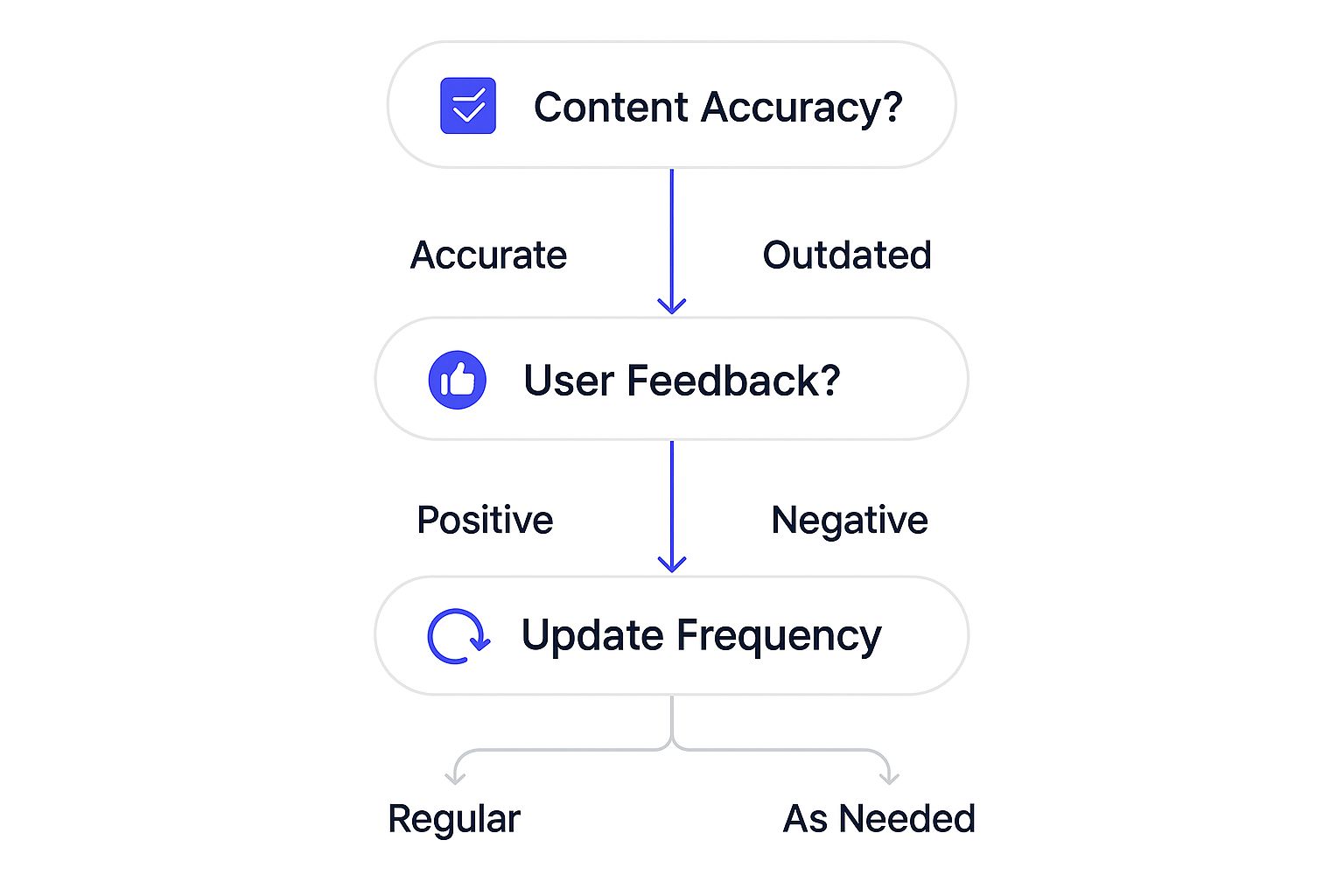A Guide to Knowledge Base Management Systems
Discover how knowledge base management systems streamline operations and improve support. Learn key features, benefits, and how to choose the right one for you.

A knowledge base management system is the software that helps a company get its collective information in one place, making it organized, accessible, and actually useful. Think of it as a central library for your business, where employees and customers can find answers on their own, fast.
This is about creating a single source of truth for your organization.
Understanding Knowledge Base Management Systems

At its heart, a knowledge base management system is designed to turn scattered information into a structured, searchable resource. It captures institutional knowledge, from product specs and troubleshooting guides to HR policies and training materials, and gets it to the right people at the right time.
Imagine a new customer support agent trying to figure out a tricky issue. Instead of interrupting a senior colleague, they just search the knowledge base and find a step-by-step guide. This self-service approach speeds up resolution times and also keeps answers consistent across the board.
Customers can often solve common problems on their own, which means fewer support tickets for your team to handle.
More Than Just Document Storage
While a tool like SharePoint is great for storing documents, a true knowledge base is built for something different. Document storage systems are like digital filing cabinets; they keep things organized, but you still have to know where to look. They're primarily for internal collaboration and file versioning.
A knowledge base management system, on the other hand, is all about quick retrieval and usability. It is built around a powerful search engine, logical categories, and content designed to deliver answers, not just files. The information is structured to be easily consumed. Getting a handle on an effective content management strategy is key to unlocking what these systems can really do.
A knowledge base turns information from a passive asset into an active tool. It’s not just about storing what you know; it’s about making that knowledge work for your team and your customers.
How Different Information Tools Compare
To see its unique role more clearly, let's stack a knowledge base management system against other common tools. Each one has a different job to do.
Information Tools at a Glance
This table breaks down the purpose, users, and core function of various information management tools, showing exactly where a knowledge base fits in.
As you can see, each tool has its place, but only a knowledge base is purpose-built to deliver structured, searchable answers at scale.
As organizations grow, the need for a system that can handle information overload becomes important. Bringing in technologies like AI takes this even further, transforming how knowledge is managed and delivered. You can see how this works by exploring the role of AI for knowledge management, which turns raw data into actionable insights. This systematic approach is what separates a real knowledge base from simpler storage solutions.
Core Features Every System Should Have

Not all knowledge base management systems are created equal. While they all promise to organize information, the best ones share a common DNA with features that turn a simple digital library into an intelligent, living resource for your whole organization.
Without these core components, you risk building something that’s hard to use, a nightmare to maintain, and ultimately, ignored by the very people it’s supposed to help.
The absolute must-have feature? A powerful and forgiving search function. It’s the front door to every piece of information in your system. If users can't find what they need in seconds, they’ll give up and ping a colleague, completely defeating the purpose of the knowledge base.
A great search tool does more than just match keywords. It should understand synonyms, let typos slide, and suggest relevant articles as someone is typing. This is how you make sure a search for "login issue" also pulls up the article titled "How to Reset Your Password."
Intuitive Content Creation and Management
Next up, a knowledge base is only as good as the content inside it. That’s why a user-friendly content editor is non-negotiable. Team members from any department, not just the technical folks, should be able to create, format, and publish articles with zero friction.
A clean, what-you-see-is-what-you-get (WYSIWYG) editor lets your contributors focus on writing clear, helpful content instead of wrestling with code. It should also make it simple to embed images, videos, and tables to make information easier to digest.
Just as important is version control. Think of it as a time machine for your content.
- It tracks every single change made to an article, showing who changed what and when.
- It lets you roll back to a previous version if a mistake slips through.
- This is important for maintaining accuracy, especially when multiple people are collaborating on the same documents.
With the right tools, you can keep your knowledge base a reliable source of truth. Mastering these fundamentals is a huge first step, and you can explore more of the best knowledge management practices to build an even stronger foundation.
Controlling Access and Understanding Performance
In any company, not all information is for everyone. This is where access permissions and user roles come into play. A solid knowledge base system lets you control exactly who can see, create, or edit specific content.
For example, you can make customer-facing troubleshooting guides public while keeping internal sales playbooks locked down to just the sales team. This kind of granular control is vital for security and for making sure people only see information that’s actually relevant to their jobs.
The real power of a knowledge base management system comes from knowing how people use it. Analytics provide the insights you need to continuously improve your content and fill information gaps before they become major problems.
Analytics and reporting are arguably the most valuable features for long-term success. These tools give you the hard data you need to answer important questions:
- Which articles are viewed most often? This tells you what topics matter most to your users.
- What search terms are coming up empty? This is a goldmine for identifying content gaps.
- Are users finding articles helpful? Simple feedback tools like a "Was this helpful?" button give you direct input on quality.
Imagine a support team notices through their analytics that searches for "billing error" have spiked by 50% in the last month. That data is a red flag. It prompts them to investigate, discover a bug in a recent software update, and quickly create a detailed article explaining a temporary fix. Without analytics, that trend might have gone unnoticed, leading to frustrated customers and a flooded support queue.
This growing reliance on smart features is a big reason why the knowledge management software market, valued at USD 23.58 billion, is projected to hit USD 59.51 billion by 2033. Businesses across all industries need smarter, more collaborative ways to manage what they know. You can discover more about this market growth on Straits Research.
How These Systems Impact Business Operations

Putting a knowledge base management system in place does more than just organize information; it fundamentally changes how your business runs day-to-day. The real value is measured in tangible results like saved time, lower operational costs, and genuinely happier customers. Think of it less as an internal convenience and more as a strategic tool for getting things done right.
One of the first things you'll notice is a big drop in repetitive support questions. When customers can easily find answers to common questions on their own, they don’t need to open a support ticket in the first place. This self-service approach helps them and builds confidence in what you offer.
This shift has a massive ripple effect on your support team's productivity. Instead of fielding the same basic questions over and over, agents can pour their energy into solving the complex, high-value customer problems that actually require their expertise.
Streamlining Internal Processes and Training
This is not just about customers, either. A central source of truth is a huge asset for your internal teams, especially when it comes to onboarding new hires. Instead of constantly tapping a busy colleague on the shoulder, new employees can find the information they need to get up to speed on their own.
This makes the entire training process faster and shrinks the time it takes for a new team member to start contributing. The bottom line? Lower training costs and a more consistent, less chaotic onboarding experience for everyone.
By making information easy to find, a knowledge base breaks down the invisible walls between departments. It ensures everyone, from sales to support, is working from the same playbook, which brings much-needed consistency to the entire customer experience.
That consistency is very important. Nothing frustrates a customer faster than when the sales team promises one thing and the support team says another. A single source of truth prevents these disconnects and gets the whole company aligned.
Quantifiable Business Growth and Efficiency
The operational improvements driven by a knowledge base lead directly to results you can actually measure. By cutting down on support ticket volume and improving first-contact resolution, businesses can seriously lower their customer service costs.
- Reduced Ticket Volume: When customers can help themselves, a huge number of common questions get deflected before they ever reach an agent.
- Faster Resolution Times: For the tickets that do come in, agents can find accurate answers in seconds, leading to quicker resolutions.
- Improved Employee Efficiency: Teams spend less time hunting for information and more time doing the work they were hired to do.
These benefits are exactly why the market for these tools is growing so quickly. The global knowledge base software market was valued at around USD 1.43 billion and is projected to hit USD 4.56 billion by 2033. This growth shows just how many businesses see these systems as needed for scaling their operations without chaos. Find more details on the market projections for knowledge base software here.
Ultimately, a well-managed knowledge base creates a more efficient, informed, and agile organization. It’s the foundation that supports sustainable growth by making both customer interactions and internal workflows smoother. The impact goes far beyond simple document storage, creating a ripple effect of productivity and satisfaction that touches every part of the business.
Choosing the Right Knowledge Base System
Picking the right knowledge base management system can feel like a huge task, especially with so many options out there. But here’s the secret: the goal isn't to find a "perfect" system. It's to find the one that fits how your company actually works. A smart decision starts with asking a few practical questions about what you really need.
Before you get lost in endless feature lists, think about the people who will be using it every single day. Who are they? Are you dealing with technical experts who love a complex interface, or are they people from all over the company who just need something that works? A system with a steep learning curve will sit unused, no matter how powerful it is.
The whole point is to choose a tool that feels natural for your team. If creating and managing content is a struggle, your knowledge base will quickly become a ghost town of outdated information.
Define Your Core Requirements
Before you even book a single demo, you need a crystal-clear picture of what the system absolutely must do. This means looking inward first. Get people from different teams (support, sales, HR, you name it) to weigh in on what they need.
Start with these fundamental questions:
- Who are the main content creators? If it's a team-wide effort, you’ll want a dead-simple editor. But if it’s a dedicated technical writer, you might need more advanced formatting options.
- Who are the primary users? Are you building this for customers to find their own answers (external) or for employees to get internal info (internal)? This changes everything, from security controls to the look and feel.
- What problem are you trying to solve? Is this about cutting down on support tickets? Speeding up employee onboarding? Or just trying to centralize documents scattered across a dozen different apps? A clear goal helps you filter out the noise.
This initial reality check stops you from getting distracted by flashy features you'll never actually use. It keeps the focus squarely on what matters to your business.
Scalability and Integration Capabilities
A knowledge base doesn’t live on an island. It has to connect smoothly with the other tools your business runs on. Think about your current software stack like your CRM, helpdesk tools like Zendesk or Jira, and communication hubs like Slack or Microsoft Teams.
A system that integrates well can pull information from other sources or push updates to your team right where they’re already working. Imagine a support agent turning a resolved ticket into a new knowledge base article with just one click. That’s the kind of efficiency that keeps valuable knowledge from getting lost.
Scalability is just as important. The system you choose today has to be ready for your growth tomorrow.
A knowledge base management system should support your business today and be ready for where you're heading tomorrow. Consider how it will handle a significant increase in content, users, and feature demands without a drop in performance.
Ask potential vendors how their pricing and infrastructure handle growth. Can you add more users without a massive price hike? Does the system crawl to a halt once you have thousands of articles? Planning for scale now saves you from a painful migration process down the road.
This decision tree gives you a simple framework for keeping your knowledge base healthy, focusing on accuracy, feedback, and regular updates.

As the graphic shows, a great system depends on a continuous loop: check that the content is right, listen to what your users are telling you, and commit to keeping everything fresh.
A Practical Evaluation Checklist
When you're ready to start comparing options, a structured checklist will be your best friend. It helps you stay objective, move beyond a gut feeling, and make a decision based on real data.
Think of this checklist as your guide to comparing different platforms fairly, making sure you focus on the factors that are most critical for your business.
Here's a simple framework to get you started.
Knowledge Base System Selection Checklist
By methodically working through these questions, you can cut through the marketing fluff and find the knowledge base management system that will genuinely help your team and support your customers for years to come.
Integrating AI Chatbots with Your Knowledge Base
A knowledge base is a fantastic tool on its own. It’s your single source of truth. But its real power gets unlocked when you pair it with an AI chatbot.
Suddenly, that static library of articles becomes an intelligent, 24/7 support channel that answers questions instantly. It transforms a collection of documents into an interactive, conversational assistant that meets users exactly where they are.
Instead of making people hunt for answers, a chatbot understands their question in plain language, digs through your knowledge base to find the most relevant snippet, and delivers a simple, helpful response. It’s immediate, on-demand support that makes the user experience so much better.
This integration also completely changes the game for your human support teams. By fielding all the common, repetitive questions, chatbots free up your agents to focus on the complex issues that actually need a human touch. This makes the team more efficient and makes their jobs more interesting.
How Chatbots Tap Into Your Knowledge
So, how does it all work? The magic happens when a chatbot is trained on your specific knowledge base content.
Using natural language processing (NLP), the chatbot can understand the intent behind what a user is asking, even if they phrase it in a weird way. It then scans the knowledge base, pinpoints the right article, and serves up the answer in a conversational format.
For example, a customer might type, "My payment didn't go through, what do I do?" The chatbot instantly recognizes this is a billing issue, finds the "Troubleshooting Failed Payments" article, and presents the core steps right there in the chat. The user gets what they need in seconds without ever having to leave the window.
This synergy is why the global knowledge management sector, which was valued at around USD 773.6 billion, is projected to rocket past USD 3.56 trillion by 2034. The demand for AI that turns information hubs into smart, responsive ecosystems is massive.
Turning Static Information into Active Assistance
Integrating a chatbot does more than just fetch answers; it turns your knowledge base into a proactive guide. It can walk users through multi-step processes, suggest related articles, or even ask clarifying questions to get to the root of the problem. Self-service becomes a dynamic and genuinely helpful experience.
This is a lifesaver for internal teams, too. An integrated chatbot can become an invaluable resource for IT support, handling common tech questions and walking employees through troubleshooting steps. You can check out our guide on using a chatbot for IT support to see just how effective this can be.
An AI chatbot connected to a knowledge base acts as a translator, converting a user's problem into a direct answer drawn from your company's collective wisdom. It makes expertise instantly accessible to everyone, at any time.
And the technology is only getting smarter. Modern chatbots can analyze conversations to spot gaps in your knowledge base. If users keep asking questions the bot can’t answer, it flags these topics for your content team. This creates a feedback loop that keeps your information constantly relevant and complete.
As you plan an integration, it’s a good idea to explore various GPT models to get a feel for the different capabilities out there. This powerful pairing of a chatbot and a knowledge base isn't just a trend, it is the future of automated, intelligent support.
Common Questions About Knowledge Base Systems
Even with a clear plan, a few practical questions always pop up when you're looking at new software. Let's tackle some of the most common ones about knowledge base management systems to clear up any lingering uncertainties before you move forward.
Getting these details sorted out helps set the right expectations for what it takes to get one up and running.
Knowledge Base vs. Wiki: What's the Difference?
A lot of people throw around "knowledge base" and "wiki" like they're the same thing, but they’re built for different jobs. While both are used to centralize information, their structure and how they're typically used are miles apart.
Think of a wiki as a collaborative, internal tool, like a shared digital notebook. Any team member with access can jump in, add content, and make edits freely. This makes it perfect for brainstorming sessions, team projects, and informal knowledge sharing.
A knowledge base, on the other hand, is usually more structured and controlled. Content is created and reviewed by designated authors and editors who follow a specific process. This formal setup is exactly what you need for official customer support documentation or internal company policies, where accuracy and consistency are non-negotiable.
The real difference comes down to control and purpose. Wikis are all about open collaboration, while knowledge bases are built to deliver structured, reliable information to specific audiences like customers or new hires.
How Much Does a System Cost?
The cost of a knowledge base can swing pretty widely. The final price tag depends on things like how many users you have, the features you need, and whether it’s a standalone tool or part of a bigger software package like a helpdesk or CRM.
Luckily, there’s a pricing model out there for just about every budget.
- Free or Basic Plans: Some tools offer free tiers that are great for small teams or just trying things out. They usually have limits on how much content you can have or how many users can access it.
- Mid-Range Solutions: Growing businesses can expect to pay anywhere from $50 to a few hundred dollars a month for systems with better features, deeper analytics, and more seats for your team.
- Enterprise Systems: Big companies often need the whole nine yards, including AI-powered search, complex integrations, and tight security controls. These platforms can run from several hundred to thousands of dollars a month.
When you're looking at the cost, don't just focus on the monthly subscription. Remember to factor in any one-time setup fees, the time it'll take to train your team, and the internal hours needed to actually create and maintain all the content. A great knowledge base is about more than just the software license.
How Long Does Implementation Take?
Getting the software itself set up is usually the fast part and can often be done in a day. The real work, and what takes the most time, is the strategic side of things: creating, organizing, and moving all your content into the new system.
The full timeline really depends on the size of your project. A great way to start is by identifying your top 10 to 20 most common customer questions and writing solid articles for those first. This approach delivers value right away. From there, you can build out your content over time. A full-blown launch with hundreds of articles and a polished structure could take several weeks of dedicated effort from your team.
Ready to turn your company's knowledge into an intelligent, on-demand resource? Chatiant lets you build a custom AI chatbot trained on your data, providing instant, accurate answers for your customers and team. Create your AI Agent with Chatiant today.


